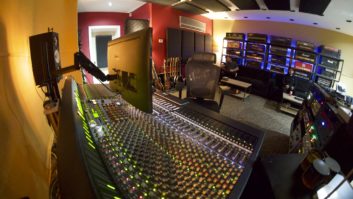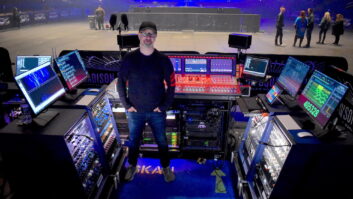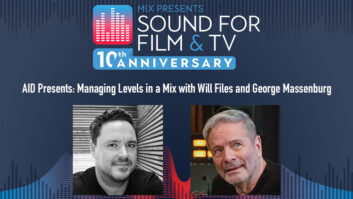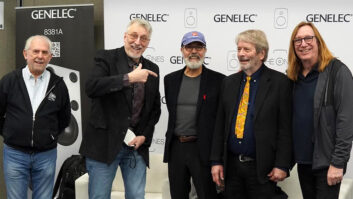Belleville, NJ—Will Putney may be known as a producer, engineer, mixer and guitarist working at the heavier end of the musical spectrum with acts like Body Count, Every Time I Die, The Acacia Strain, and Thy Art Is Murder, but when it comes to recording the heavy stuff, for him, it’s all about the drum sound.
Most of his projects are produced at Graphic Nature Audio (FB: @GraphicNatureAudio), his own 5,000-square-foot facility. While it features five control rooms, the centerpiece is—surprise—a large drum room. “The ceiling is about 18 feet. When we were looking for a spot, we were walking into buildings and warehouses with a snare drum and laptop, seeing what the rooms sounded like. This place instantly sounded good. It wouldn’t have been the sole deciding factor when we were looking, but the fact that it was good right away made for a very easy, hassle-free drum room setup.”
Putney started out with producer Machine—otherwise known as Gene Freeman—at his Machine Shop recording studio. “I worked out of his studio for a couple of years, then we moved to this spot about nine years ago. We shared it for a year or two, then he moved to Texas and I took over, so this has been solely my place for six years or so,” Putney says. “When he left, we expanded, built some rooms and finished the drum room. Now it’s officially my spot.”
The sound of the drums is obviously critical to a Putney production. For the style of music he specializes in, he says, he probably uses a lot more room mics than most people. “For metal stuff, I’m usually a bit more miked up on the drum input side, and I’ve got a pretty gnarly setup of different room mics.” Speaking of mics, “I just picked up a Stam Audio SA-47. That has quickly become one of my favorite microphones,” he says.
Conclave Studios Nurtures Metal Musicians, by Strother Bullins, Jan. 13, 2016
Much of the outboard gear in the main control room might be found in any professional facility. “There’s nothing too unconventional,” he says, adding, “I’m definitely a Distressor guy.” There are a few other items of outboard he also enjoys using. “I just picked up a Curve Bender [from Chandler]. I love that thing. It may be my favorite mix EQ ever.”
He recently expanded his mixing setup. “I was using a Shadow Hills Equinox and a Dangerous 2-Bus but recently moved to all-Dangerous summing. I have two stages of summing, before and after the bus compression.”
These days, mix recalls and other last-minute demands constantly pull producers from one project to another. In a hybrid workflow, that means having to reset hardware, but Putney and his team have it covered: “We make recall videos of our analog gear. I can recall eight compressors, 12 EQs and a summing mixer in five minutes.”
Two years ago, he installed a pair of Amphion Two18 nearfields, replacing two sets of monitors that, between them, just weren’t cutting it. “I was having trouble placing low end and low mids in my mixes,” he reports. “The Amphions took care of that for me, big time.”
Howard Benson Guitar Plug-In Suite Debuts, Nov. 9, 2018
While most of Putney’s projects are produced at Graphic Nature Audio, he also works elsewhere—on one condition. “Without a good drum room, I’m never interested,” he says.
Two studios stand out. “I really liked Sing Sing in Australia: tons of vintage gear, really cool mic collection, good sounding rooms,” he says. “It was a lot of fun to record bands there.” (The original studio closed in 2016 after more than 30 years. Sing Sing East builds on that legacy at another location.)
“The Goo Goo Dolls guys have a really nice studio in Buffalo called GCR Audio,” he adds. “That’s a really cool studio with an awesome sounding drum room.”
Despite all that focus on the drums, Putney has become known for his guitar tone, not just in the studio but also as a guitarist with Fit for an Autopsy and END—so much so that eventually STL Tones contacted him about replicating some signature guitar setups in a plug-in. While intrigued, it took him time to warm to the idea—that, and an audition of sorts.
Putney had only ever heard one amplifier simulation that he enjoyed, he says, so when STL Tones told him they’d hired the software engineer behind it, Federico Berti, it caught his attention. “I think he’s the best in the world,” says Putney.

Yet he was still hesitant. “I thought, I’m going to give you an amp I know super well, run a million tests and send you every variation of file and setting, thousands of variations of tones, with and without speaker cab. If it’s cool, we’ll move forward. And he nailed it. It was the first time I was ever convinced that software could be as good as if I pulled the amps up right now.”
The result is the STL Tonality Will Putney Guitar Plug-In Suite, which captures the distinctive tones that Putney conjures from the guitar and bass amp collection at his facility. The software suite offers a choice of five amps, three pedals (distortion, delay and reverb), Putney’s collection of cabinets, a master EQ section, and a mixer for blending different amp and cab combinations.
An avowed “hybrid guy” who tracks and mixes in Apple Logic Pro, he says, “I have a lot of stuff to give me good tones on the way in, and on the mixing side, I mix through gear and summing mixers. But I do the bulk of my work in the computer. It’s just more efficient for me. I’m not really a console guy.”
Not unlike pop music, metal has become somewhat homogenous in recent years. Putney, however, marches to a different drummer, preferring a natural production style more reminiscent of the genre’s early days. “I try to make these heavy productions a bit more organic. Records can very quickly become sterile and overproduced. I leave them a little more raw and a little less sampled,” he says. “I don’t use templates and setups, and I don’t follow a standard for each record. I find what’s cool about the band and emphasize that in the project.”
Want more stories like this? Subscribe to our newsletter and get it delivered right to your inbox.
Sticking to that strategy made 2018 his favorite year so far, he says. “I got to make more records last year that felt more original.” That’s not to diss any previous projects, he stresses, “But it was more the taste I liked, and the type of bands I like. It was a good year for me being creatively satisfied and not just making records to service other people.”
STL Tones • www.stltones.com
Graphic Nature Audio • www.graphicnatureaudio.com







